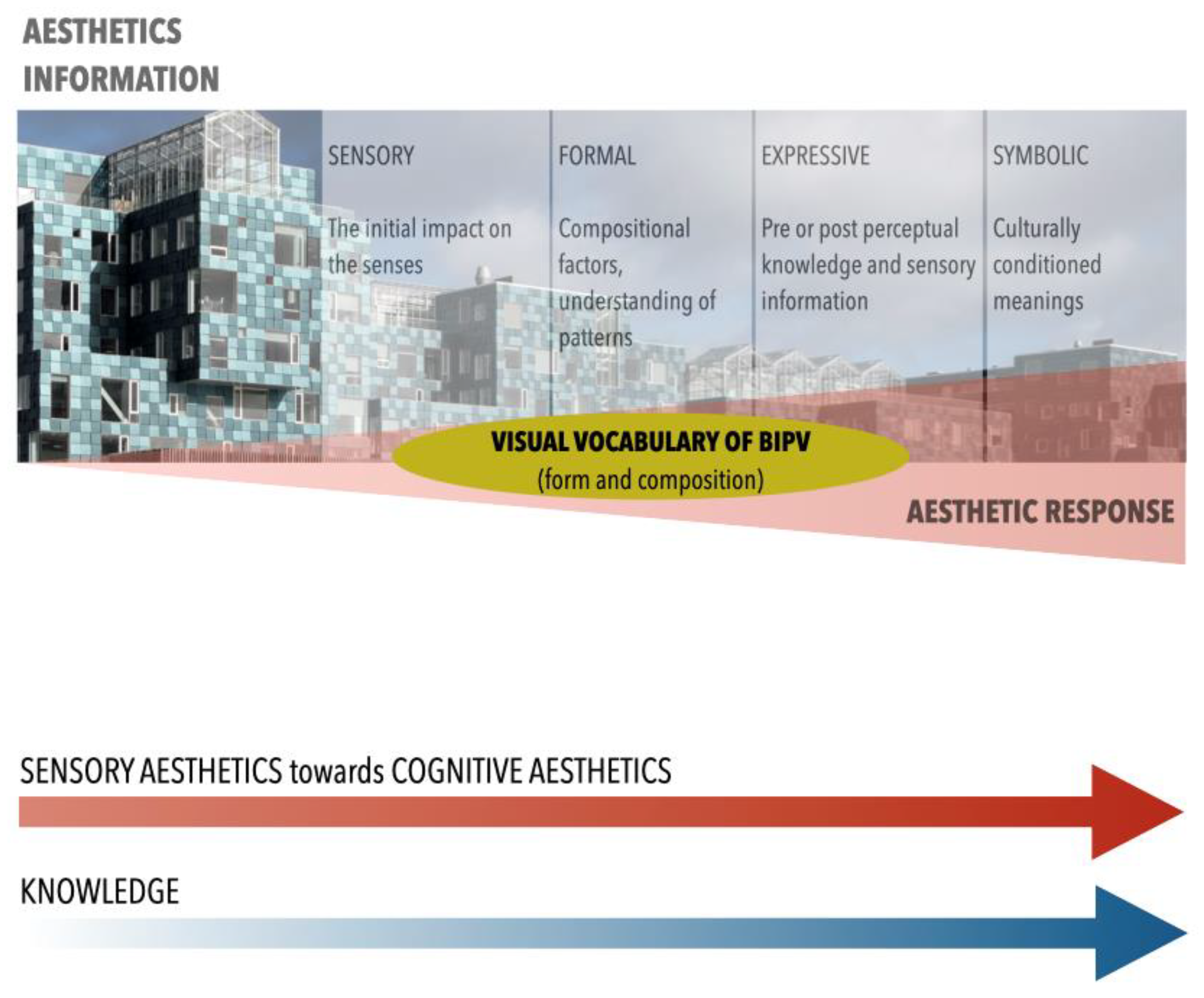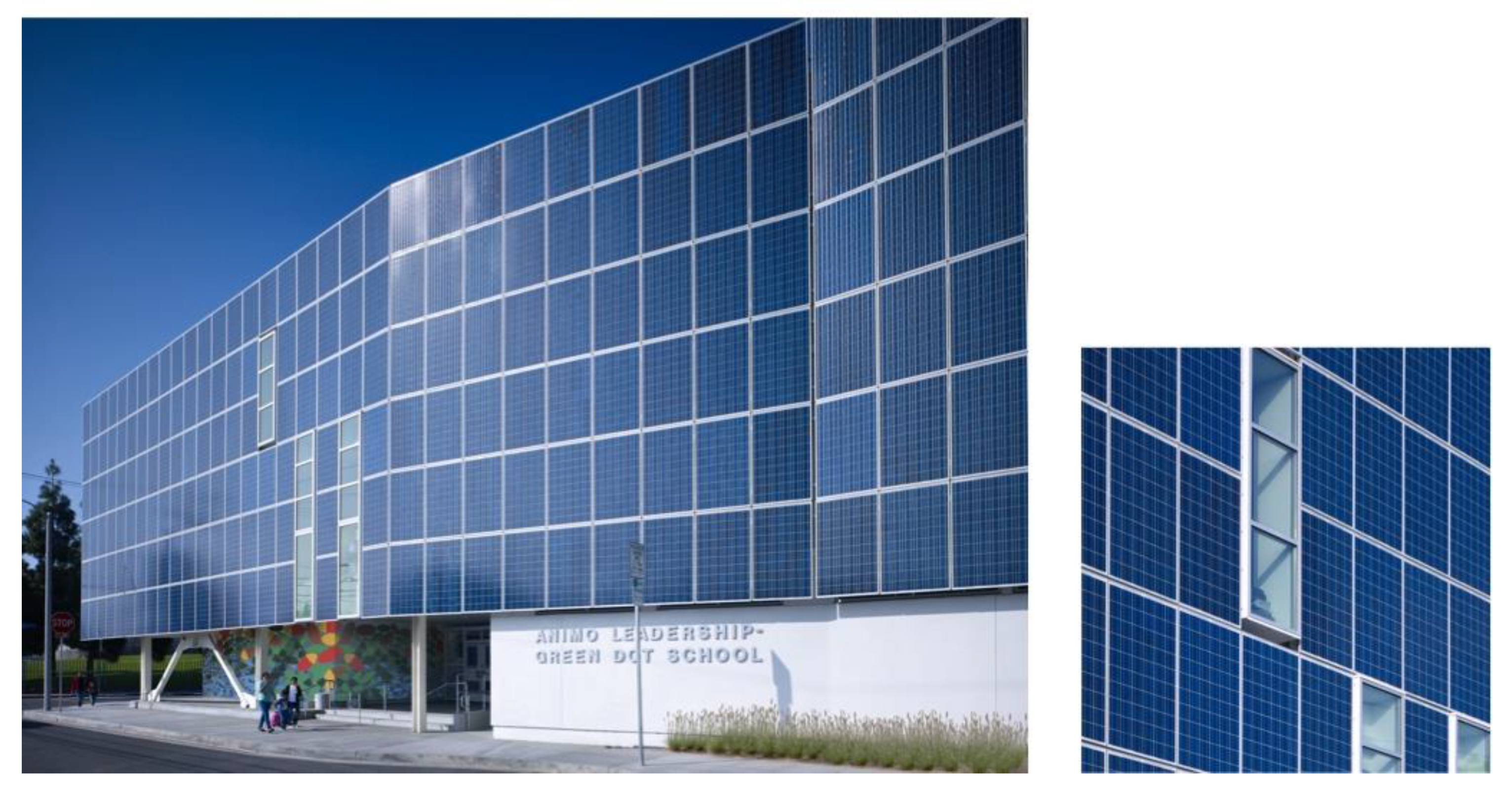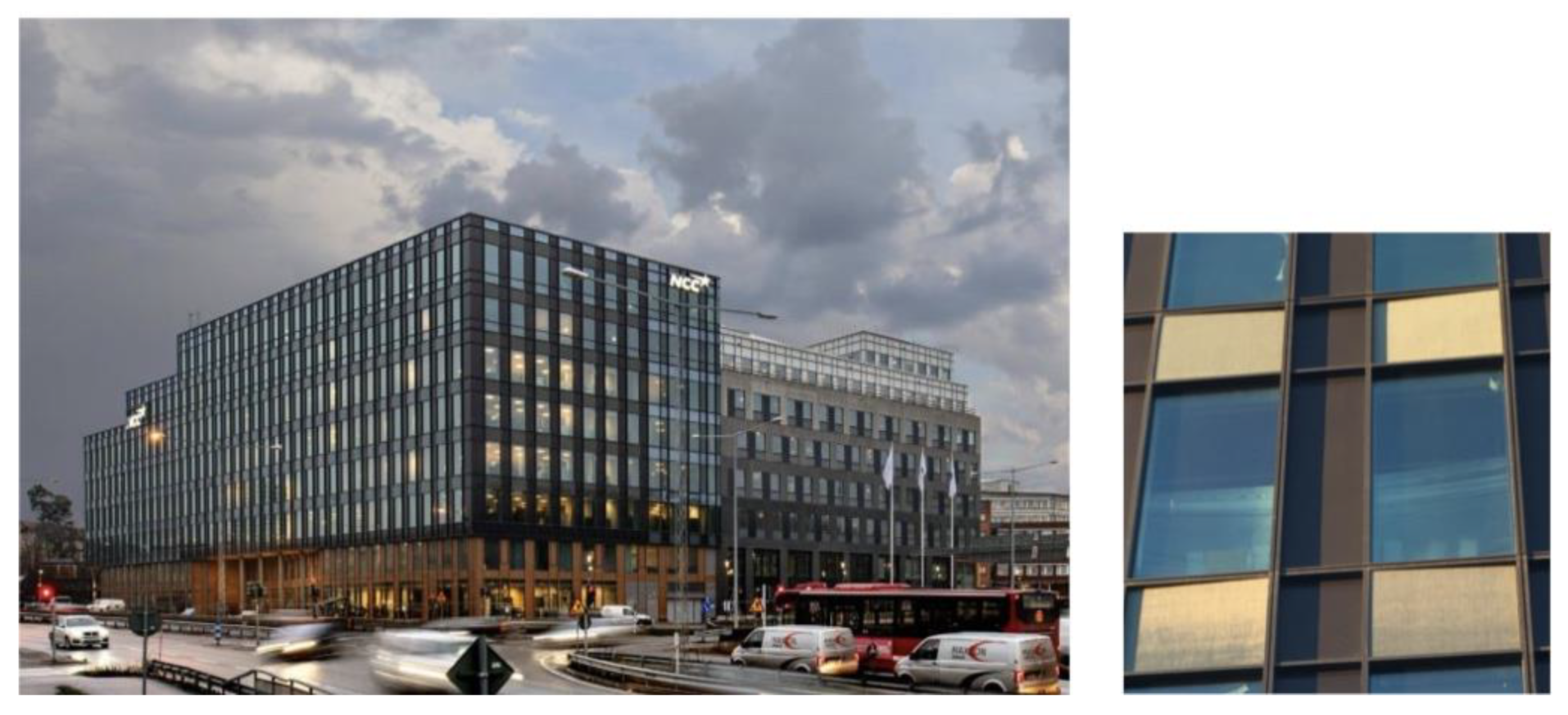A Trans-Disciplinary Vocabulary for Assessing the Visual Performance of BIPV
Abstract
:1. Introduction
2. Methodological Approach
- Identification of the individual visual elements (the “leaves”);
- Formalization of a hierarchical configuration of the individual visual elements (leaves) into subtrees and trees, to the highest level of a tree, the root node.
- The building mosaic pattern, which includes the BIPV system as a tile of the mosaic;
- The BIPV system, which includes the BIPV components;
- The BIPV components, which include PV units and materials.
3. Theoretical Framework: The BIPV System as a Polysemous Sign
3.1. BIPV as a Photovoltaic System
3.2. BIPV as a Part of the Building Envelope
- For the facade: rainscreen facade, double-skin facade, curtain wall, window, and masonry wall.
- For the roof: discontinuous roofing, continuous roofing, and atrium/skylight.
- For the external integrated device: parapet, balustrade, canopy, and solar shading [28].
3.3. BIPV as a Visual Image
3.3.1. Variants of BIPV (Customization Degree)
3.3.2. The Need for a Visual Vocabulary for BIPV
3.3.3. Recognizability (Invariants of BIPV)
3.3.4. Are Shape, Size, and Color Sufficient?
3.3.5. Are Shape, Size, Color, and Pattern Sufficient?
3.3.6. Are Shape, Size, Color, Pattern(s), and Texture Sufficient?
3.4. The Power of Texture
4. BIPV in the Building’s Mosaic Pattern: Translating Technical Knowledge into Visual Language
4.1. Cross-Scale Analysis and Related Issues
4.2. A New Eye on BIPV and the Appropriate Visual Concepts: The Pattern–Patch–Matrix Model
4.2.1. Pattern
4.2.2. Patch
4.2.3. Matrix
5. Trans-Disciplinary and Hierarchical Formalization of BIPV
5.1. The Coarse Scale: The BIPV System as a Patch in the Building’s Mosaic Pattern
5.1.1. Building Envelope Technology (Topology/Morphology)
5.1.2. Mosaic Type
5.1.3. The BIPV System (Pattern, Patch, and Matrix)
5.2. The Medium, and the Fine Scale: The PV Patch
5.2.1. Patch
5.2.2. Matrix
6. Application of the Descriptive Model (Visual Vocabulary and Semiology) to Real Case Studies
6.1. Translating Visual Performance Parameters into Visual Features (Use Ovf Vocabulary and Semiology)
6.2. Describing BIPV as a Polysemic Sign, Using a Visual Approach
6.2.1. Green Dot Animo Leadership High School, Inglewood, California (USA), 2013, Designed by Brooks + Scarpa Architects
6.2.2. CMB Headquarters, Rome (IT), 2006, Designed by 3c+t Capolei Cavalli Associati
6.2.3. NCC Headquarters, Solna (SE), 2019, Designed by White Arkiteckter
6.2.4. Apartment Building on Hofwiesen- and Rothstrasse, Zürich (CH), 2016, Designed by Viridén + Partner (Only Qualitative Description)
6.2.5. Copenhagen International School, Copenhagen (DK), 2017, Designed by C. F. Møller Architects (Only Qualitative Description)
7. Conclusions
Funding
Institutional Review Board Statement
Informed Consent Statement
Data Availability Statement
Acknowledgments
Conflicts of Interest
References
- Leder, H.; Belke, B.; Oeberst, A.; Augustin, D. A Model of Aesthetic Appreciation and Aesthetic Judgments. Br. J. Psychol. 2004, 95, 489–508. [Google Scholar] [CrossRef] [PubMed]
- Rahman, S.R.A.; Ahmad, H.; Mohammad, S.; Rosley, M.S.F. Perception of Green Roof as a Tool for Urban Regeneration in a Commercial Environment: The Secret Garden, Malaysia. Procedia Soc. Behav. Sci. 2015, 170, 128–136. [Google Scholar] [CrossRef] [Green Version]
- Bell, S. Elements of Visual Design in the Landscape, 3rd ed.; Routledge: London, UK, 2019; ISBN 978-0-367-02447-5. [Google Scholar]
- Del Torres-Sibille, A.C.; Cloquell-Ballester, V.-A.; Cloquell-Ballester, V.-A.; Artacho Ramírez, M.Á. Aesthetic Impact Assessment of Solar Power Plants: An Objective and a Subjective Approach. Renew. Sustain. Energy Rev. 2009, 13, 986–999. [Google Scholar] [CrossRef]
- Xu, R.; Wittkopf, S.; Roeske, C. Quantitative Evaluation of BIPV Visual Impact in Building Retrofits Using Saliency Models. Energies 2017, 10, 668. [Google Scholar] [CrossRef] [Green Version]
- Lu, M.; Lin, A.; Sun, J. The Impact of Photovoltaic Applications on Urban Landscapes Based on Visual Q Methodology. Sustainability 2018, 10, 1051. [Google Scholar] [CrossRef] [Green Version]
- Sánchez-Pantoja, N.; Vidal, R.; Pastor, M.C. Aesthetic Perception of Photovoltaic Integration within New Proposals for Ecological Architecture. Sustain. Cities Soc. 2018, 39, 203–214. [Google Scholar] [CrossRef]
- Probst, M.C.M.; Roecker, C. Criteria and Policies to Master the Visual Impact of Solar Systems in Urban Environments: The LESO-QSV Method. Sol. Energy 2019, 184, 672–687. [Google Scholar] [CrossRef]
- Probst, M.M.; Roecker, C. Criteria for Architectural Integration of Active Solar Systems IEA Task 41, Subtask A. Energy Procedia 2012, 30, 1195–1204. [Google Scholar] [CrossRef] [Green Version]
- Falcinelli, R. Guardare, Pensare, Progettare: Neuroscienze Per Il Design; Stampa Alternativa & Graffiti: Rome, Italy, 2011; ISBN 88-6222-173-8. [Google Scholar]
- Marković, S. Components of Aesthetic Experience: Aesthetic Fascination, Aesthetic Appraisal, and Aesthetic Emotion. Iperception 2012, 3, 1–17. [Google Scholar] [CrossRef] [PubMed]
- Feldman, J. What Is a Visual Object? Trends Cogn. Sci. 2003, 7, 252–256. [Google Scholar] [CrossRef]
- Francavilla, C. Teoria Della Percezione Visiva e Psicologia Della Forma; Schena Editore: Fasano, Italy, 2019; ISBN 88-6806-230-5. [Google Scholar]
- Arnheim, R.; Pedio, R. Il Pensiero Visivo: [La Percezione Visiva Come Attività Conoscitiva]; Einaudi: Torino, Italy, 1974; ISBN 88-06-03440-5. [Google Scholar]
- Arnheim, R. Arte e Percezione Visiva; Feltrinelli: Milan, Italy, 2002; ISBN 88-07-10023-1. [Google Scholar]
- Arnheim, R. Pensiero Visuale; Mimesis: Milan, Italy, 2013; ISBN 978-88-575-1719-3. [Google Scholar]
- Morin, E. La Testa Ben Fatta. Riforma Dell’insegnamento e Riforma Del Pensiero; Cortina Raffaello: Milan, Italy, 2000; ISBN 88-7078-613-7. [Google Scholar]
- Fusco, R.D. Segni, Storia e Progetto di Architettura; Laterza: Bari, Italy, 1989; ISBN 88-420-3327-8. [Google Scholar]
- Scognamiglio, A. ‘Photovoltaic Landscapes’: Design and Assessment. A Critical Review for a New Transdisciplinary Design Vision. Renew. Sustain. Energy Rev. 2016, 55, 629–661. [Google Scholar] [CrossRef]
- Scognamiglio, A.; Garde, F. Photovoltaics’ Architectural and Landscape Design Options for Net Zero Energy Buildings, towards Net Zero Energy Communities: Spatial Features and Outdoor Thermal Comfort Related Considerations. Prog. Photovolt. 2016, 24, 477–495. [Google Scholar] [CrossRef]
- Ballif, C.; Perret-Aebi, L.-E.; Lufkin, S.; Rey, E. Integrated Thinking for Photovoltaics in Buildings. Nat. Energy 2018, 3, 438–442. [Google Scholar] [CrossRef]
- Scognamiglio, A. Chapter 6—Building-Integrated Photovoltaics (BIPV) for Cost-Effective Energy-Efficient Retrofitting. In Cost-Effective Energy Efficient Building Retrofitting; Pacheco-Torgal, F., Granqvist, C.-G., Jelle, B.P., Vanoli, G.P., Bianco, N., Kurnitski, J., Eds.; Woodhead Publishing: Cambridge, UK, 2017; pp. 169–197. ISBN 978-0-08-101128-7. [Google Scholar]
- Mercaldo, L.V.; Addonizio, M.L.; Noce, M.D.; Veneri, P.D.; Scognamiglio, A.; Privato, C. Thin Film Silicon Photovoltaics: Architectural Perspectives and Technological Issues. Appl. Energy 2009, 86, 1836–1844. [Google Scholar] [CrossRef]
- Shukla, A.K.; Sudhakar, K.; Baredar, P. Recent Advancement in BIPV Product Technologies: A Review. Energy Build. 2017, 140, 188–195. [Google Scholar] [CrossRef]
- Ghosh, A. Potential of Building Integrated and Attached/Applied Photovoltaic (BIPV/BAPV) for Adaptive Less Energy-Hungry Building’s Skin: A Comprehensive Review. J. Clean. Prod. 2020, 276, 123343. [Google Scholar] [CrossRef]
- Scognamiglio, A. Impiego del fotovoltaico negli edifici e scelta dei componenti appropriati. In Fotovoltaico Negli Edifici; Edizioni Ambiente: Milan, Italy, 2013; Volume 501, pp. 211–262. ISBN 978-88-6627-025-6. [Google Scholar]
- Kuhn, T.E.; Erban, C.; Heinrich, M.; Eisenlohr, J.; Ensslen, F.; Neuhaus, D.H. Review of Technological Design Options for Building Integrated Photovoltaics (BIPV). Energy Build. 2021, 231, 110381. [Google Scholar] [CrossRef]
- IEA PVPS Task 15.2. Categorization of BIPV Applications, Breakdown and Classification of Main Individual Parts of Building Skin Including BIPV Elements. Unpublished work.
- Wohlgemuth, J.H. Photovoltaic Module Reliability; John Wiley & Sons Ltd.: Hoboken, NJ, USA, 2020; ISBN 978-1-119-45901-9. [Google Scholar]
- Scognamiglio, A.; Graditi, G.; Pascarella, F.; Privato, C. Boogie-Woogie, a Photovoltaic Glass-glass Module “Dancing” with the Building. In Proceedings of the 21st EUPVSEC, Dresden, Germany, 4–8 September 2006; pp. 2853–2856. [Google Scholar]
- Pellegrino, M.; Flaminio, G.; Leanza, G.; Privato, C.; Scognamiglio, A. Aesthetical Appeal of BIPV or Electrical Performance. In Proceedings of the PV in Europe-From PV Technology to Energy Solutions, Rome, Italy, 7–11 October 2002; pp. 1109–1112. [Google Scholar]
- Scognamiglio, A.; Graditi, G.; Pascarella, F.; Privato, C. Boogie Woogie, BIPV Module. Patent RM2005A000060, 11 February 2005. [Google Scholar]
- European Commission CONSTRUCT-PV Project. Available online: https://cordis.europa.eu/project/id/295981/it (accessed on 16 February 2021).
- Unstudio Photovoltaic Modules: Collaboration with Construct PV, Part 1. Available online: https://www.unstudio.com/en/page/5888/photovoltaic-modules-collaboration-with-construct-pv-part-1 (accessed on 16 February 2021).
- Van Berkel, B.; Minderhoud, T.; Piber, A.; Gijzen, G. Design Innovation from PV-Module to Building Envelope: Architectural Layering and Non Apparent Repetition. In Proceedings of the 29th European Photovoltaic Solar Energy Conference and Exhibition, Amsterdam, The Netherlands, 22–26 September 2014; pp. 3606–36012. [Google Scholar]
- Van Berkel, B.; Bos, U.N.; Studio, B.V. ENEA, SUPSI, Meyerburger AG, Fraunhofer ISE, D’Appolonia. Design Patent 002845511-0001, 2 November 2015. [Google Scholar]
- Compáz High-Resolution Photovoltaic Pictures. Available online: https://compaz.art/en/projects/kaleo#if-billboards-could-provide-energy (accessed on 16 February 2021).
- CSEM White and Colored Solar Modules. Available online: https://www.csem.ch/white-pv (accessed on 16 February 2021).
- NRP Energy Aesthetic Power Production: Colourful Photovoltaic Systems to Promote the Development of Solar Energy. Available online: https://nfp-energie.ch/en/projects/1001 (accessed on 16 February 2021).
- Lupyan, G.; Abdel Rahman, R.; Boroditsky, L.; Clark, A. Effects of Language on Visual Perception. Trends Cogn. Sci. 2020, 24, 930–944. [Google Scholar] [CrossRef] [PubMed]
- Kepes, G. Language of Vision; Paul Theobald and Company: Chicago, IL, USA, 1944. [Google Scholar]
- Bell, S. Landscape: Pattern, Perception and Process; Routledge: London, UK, 2012; ISBN 978-0-203-12008-8. [Google Scholar]
- Monica, G.T.; Robert, H. Gardner Landscape Ecology in Theory and Practice. Pattern and Process; Springer: New York, NY, USA, 2015; ISBN 978-1-4939-2794-4. [Google Scholar]
- Forman, R.T.T. Land Mosaics: The Ecology of Landscapes and Regions; Cambridge University Press: Cambridge, UK, 1995; ISBN 978-0-521-47980-6. [Google Scholar]
- Albers, J. Interazione Del Colore. Esercizi per Imparare a Vedere; Il Saggiatore: Milan, Italy, 2013; Volume 107, ISBN 978-88-428-1985-1. [Google Scholar]
- Munari, B. Design e Comunicazione Visiva; Laterza: Bari, Italy, 2017; pp. 89–91. ISBN 978-88-581-2878-7. [Google Scholar]
- International Electrotechnical Commission. IEC 61215-1-1:2021 ED2 Terrestrial Photovoltaic (PV) Modules—Design Qualification and Type Approval—Part 1-1: Special Requirements for Testing of Crystalline Silicon Photovoltaic (PV) Modules; International Electrotechnical Commission: Geneva, Switzerland, 2021. [Google Scholar]
- International Electrotechnical Commission. IEC 61215-1:2021 Terrestrial Photovoltaic (PV) Modules—Design Qualification and Type Approval—Part 1: Test Requirements; International Electrotechnical Commission: Geneva, Switzerland, 2021. [Google Scholar]






























| Scale | Envelope, Main Visual, and Technological Design Issues |
|---|---|
| Coarse The building envelope technology systems are described. Where and how the BIPV system is integrated. | Building Envelope Technology Systems Topology Roof, facade, external integrated device. Morphology Rainscreen facade, double-skin facade, curtain wall, window, and masonry; discontinuous roofing, continuous roofing, and atrium/skylight; parapet, balustrade, canopy, and solar shading. |
| Medium The building envelope technology subsystems are described. The BIPV description entails how the BIPV system is integrated, the main features of the module. | Building Envelope Technology Subsystems Sub-technological subsystems. PV modules and framing systems. |
| Fine The building envelope technology sub-systems are described. The BIPV description entails how the PV module is realized so as to get a desired visual effect (components and materials). | Building Envelope Technology Components and Materials Building envelope technological units. PV modules. Visual/technical description of the PV modules. Front layer (pattern and transparency degree) PV layer (technology and pattern) Back layer (color and transparency degree) |
| Visual Concepts | Visual Parameters Definitions and Specific Features |
|---|---|
| Pattern | Specific arrangement of spatial elements, often used synonymously with spatial structure or patch structure. |
| Pattern is the arrangement of the patches. At the BIPV system scale (medium scale), this is the spatial arrangement of the photovoltaic modules into the BIPV system; at the module scale (fine scale), this is the spatial arrangement of the photovoltaic cells into the photovoltaic module. | |
| Geometry | The geometry of a pattern can vary, being irregular or irregular. In most cases, due the constraints imposed by the technology both at the system and at the modules scale, the typical geometries of photovoltaics are regular. Mainly these are based on parallel stripes compositions, or on grid compositions. The variable is the distancing between the stripes and/or the distancing between the cells. |
| Density | In general, in order to allow for the maximum density of power, the photovoltaic modules are characterized by a dense pattern. Nevertheless, porous patterns can be used if a certain degree of transparency is required. The measure of the “pore” space defines the degree of transparency of the component. |
| Patch | Surface area that differs from its surroundings in nature or appearance. |
| At the building scale (coarse scale) this is the whole BIPV system; at the BIPV system scale (medium scale), this is the PV module; at the module scale (fine scale), this is the single cell (if present and visible). For all the elements the description and the assessment are both qualitative and quantitative. | |
| Size | |
| Shape | |
| Position | |
| Border | |
| Color | |
| Transparency | |
| Texture | |
| Matrix | Background cover type in a landscape, characterized by extensive cover and high connectivity; not all landscapes have a definable matrix. |
| Similarly, to landscapes, not all BIPV systems have a definable matrix. The matrix is mostly used in this study for describing the space that is in between the modules in a porous pattern, or what is in between the cells in a module. The matrix is therefore strictly related to a porous pattern. An attribute of the matrix is the transparency, as often it corresponds to the use of glass in the BIPV system pattern, or in the BIPV module.St the fine scale, the matrix can be also visible in a porous pattern. For all the elements the description and the assessment are both qualitative and quantitative. | |
| Transparency | |
| Color |
Publisher’s Note: MDPI stays neutral with regard to jurisdictional claims in published maps and institutional affiliations. |
© 2021 by the author. Licensee MDPI, Basel, Switzerland. This article is an open access article distributed under the terms and conditions of the Creative Commons Attribution (CC BY) license (https://creativecommons.org/licenses/by/4.0/).
Share and Cite
Scognamiglio, A. A Trans-Disciplinary Vocabulary for Assessing the Visual Performance of BIPV. Sustainability 2021, 13, 5500. https://doi.org/10.3390/su13105500
Scognamiglio A. A Trans-Disciplinary Vocabulary for Assessing the Visual Performance of BIPV. Sustainability. 2021; 13(10):5500. https://doi.org/10.3390/su13105500
Chicago/Turabian StyleScognamiglio, Alessandra. 2021. "A Trans-Disciplinary Vocabulary for Assessing the Visual Performance of BIPV" Sustainability 13, no. 10: 5500. https://doi.org/10.3390/su13105500





